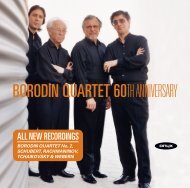BRAHMS Piano Quartets 1 & 3 - Onyx Classics
BRAHMS Piano Quartets 1 & 3 - Onyx Classics
BRAHMS Piano Quartets 1 & 3 - Onyx Classics
Sie wollen auch ein ePaper? Erhöhen Sie die Reichweite Ihrer Titel.
YUMPU macht aus Druck-PDFs automatisch weboptimierte ePaper, die Google liebt.
Brahms’ revisions included lowering its key from C sharp minor to C minor, rewriting the original<br />
finale to become the scherzo and composing both the glorious Andante and a new finale. The work<br />
was finally completed in 1874 and premiered in the Musikverein in November 1875, with Brahms at<br />
the piano and Hellmesberger playing the violin. The audience included Richard and Cosima Wagner,<br />
attending in a (as it turned out, temporary) gesture of reconciliation.<br />
For all its subtext, Clara Schumann was again critical of the C minor Quartet’s opening movement. The<br />
opening few bars of the first movement feature a string sonority almost as plangent as a Purcell viol<br />
Fantazia; this stark quality, contrasting with the unfettered Romanticism heard elsewhere, also offers<br />
moments of reflection amid the overwhelming passion of the scherzo. There is respite, too, in the first<br />
movement’s autumnal second subject area, and in the poignant second theme of the scherzo. But<br />
there is no trio to balance the scherzo’s intensity, betraying its original conception as a finale.<br />
The gorgeous Andante brings sensual interplay between the strings, creating a quintessentially<br />
Brahmsian mood of mingled wistfulness and warmth. The finale opens with a long violin solo over<br />
inexorable moto perpetuo quavers, followed by a string chorale with sardonic interjections from the<br />
piano. After a shadowy development, the chorale theme is ferociously reiterated on the piano,<br />
before the terse final chords bring extinction. There is no peaceful resolution – let alone the gypsystyle<br />
celebration of the earlier G minor quartet – but a triumph of desolation, as befits the suicidal<br />
subject matter alluded to by Brahms. Here at least, Friedrich Nietzsche may have had a point when<br />
he described Brahms as ‘the musician of the unsatisfied’.<br />
Joanna Wyld, 2008















